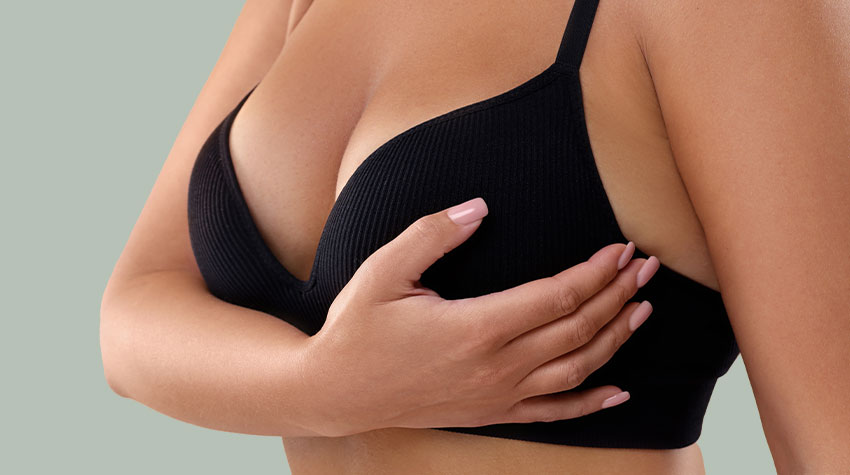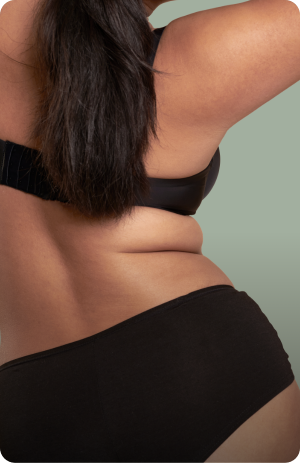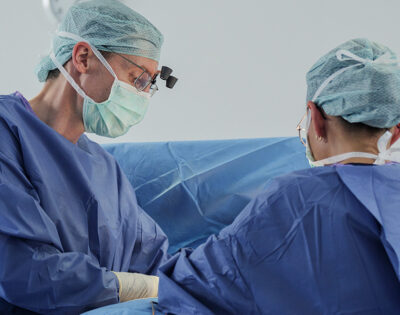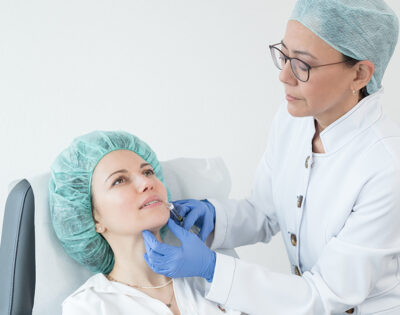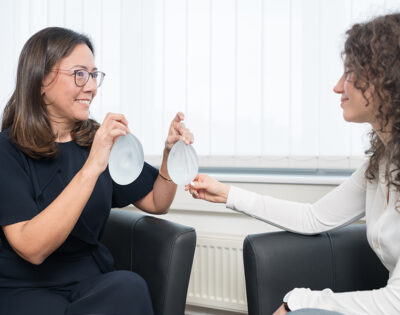Breast reduction in Saarbrücken
Breasts that are too large and therefore too heavy can cause physical complaints such as shoulder, back or neck pain. The weight of the breasts can cause a stooped posture and thus lead to health problems. Women with extremely voluminous breasts also find it difficult to find clothes that fit the size of their breasts. Due to the weight of the breasts, many women suffer from incisive bra straps. Skin rashes can occur in the underbust crease, especially in the warmer months.
In addition, patients with a very large bust also report performance restrictions due to the heavy breasts and a feeling of shame due to the movements of large breasts during sport. Even a sports bra won’t help if you have excessively large breasts. Some women even complain of impaired breathing due to the pressure of the breasts. Many women report a psychological burden because their large breasts unwantedly attract everyone’s attention. Those affected complain that the size of the breasts is perceived as inharmonious and affects their self-confidence.
For this reason, some women purchase so-called minimizer bras to conceal their bust size, but this cannot solve many of the problems described above and can only provide limited visual relief. Excessive bust size can also have a negative effect on your sex life and in extreme cases can cause anxiety or depression. Breast reduction, also known as mammary reduction, facilitates physical activity and motivates weight loss 1 .
What our patients say
Information at a glance
Operation duration
approx. 2-3 hours
Aftercare
6 weeks
Anesthesia
Twilight sleep
Thread tension
Self-dissolving threads
Hospitalization
Outpatient
Socially acceptable
after 5 days
Costs
Additions or alternatives

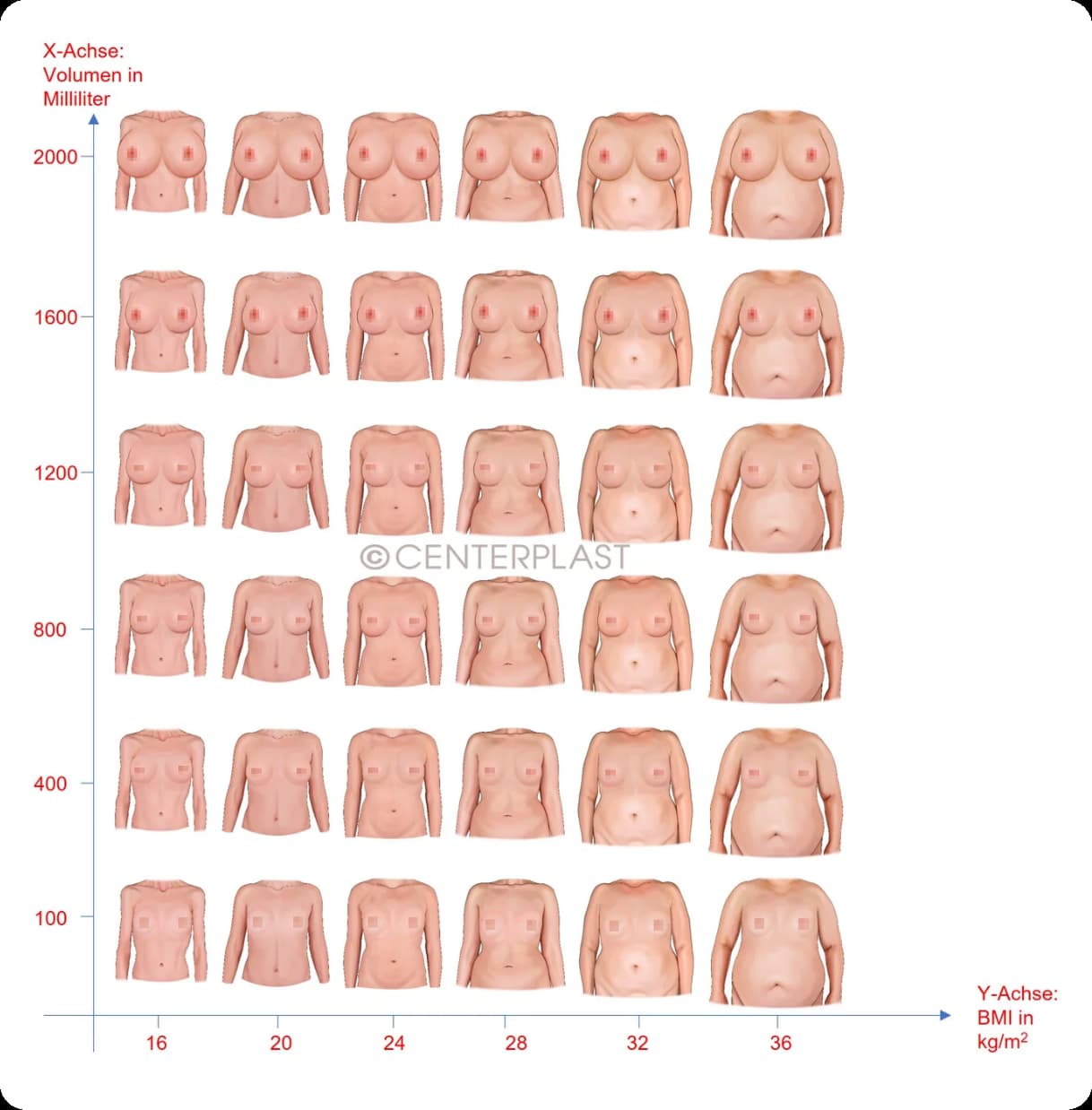
What is a breast reduction?
During a breast reduction or “mammary reduction”, excess skin and mammary gland tissue is removed to correct the size and position of the breast. At the same time, the nipple is moved to give the breast a youthful appearance. For an optimal result, the areola is often also reduced in size. The incision is made around the areola, in the underbust crease and along a connecting line between these points.
Knowledge of different surgical techniques is important in order to be able to do justice to different findings and wishes. In addition to the reduction in size, special attention is always paid to harmonious proportions and optimal symmetry and shape of the breasts.
The size of a woman’s breast is naturally in proportion to her physique. Different sizes of female breast occur in different frequencies in the population. Average sizes are the most frequently occurring sizes. The most frequently occurring sizes correspond to the images of the diagonal from bottom left to top right in the image. For a natural result, we recommend aiming for an average-sized breast.
What methods of breast reduction are there?
What all surgical methods have in common is the removal of excess breast tissue (mammary gland tissue and fatty tissue) and skin. Each surgical technique has certain advantages and disadvantages. Depending on the size and shape of the breasts, the advantages or disadvantages of a particular technique may outweigh the disadvantages. The key to a perfect result therefore lies in the selection of the surgical method that is specifically suitable for you, which is characterized by the incision and incision technique:
A distinction is made between an O technique (Benelli method), an I technique, a J or L technique and a T technique. The O-technique is mainly suitable for tightening slightly sagging breasts. The T-technique is usually used for a noticeable reduction or tightening of the breast. You can find out more about this on our “Breast lift” page.
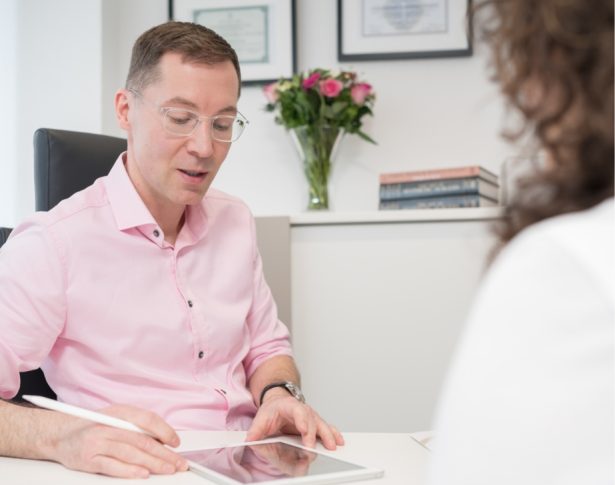

Combination of a breast reduction with liposuction
The combination of liposuction and breast reduction makes it possible to perform scar-saving and gentle surgery. Liposuction is helpful in shaping the lateral breast contours. Excess fat (fat pads) in front of the armpit can also be corrected. In the case of very large breasts, the combination of breast reduction and liposuction makes a lot of sense in order to promote fast and safe wound healing.
Breast reduction procedure
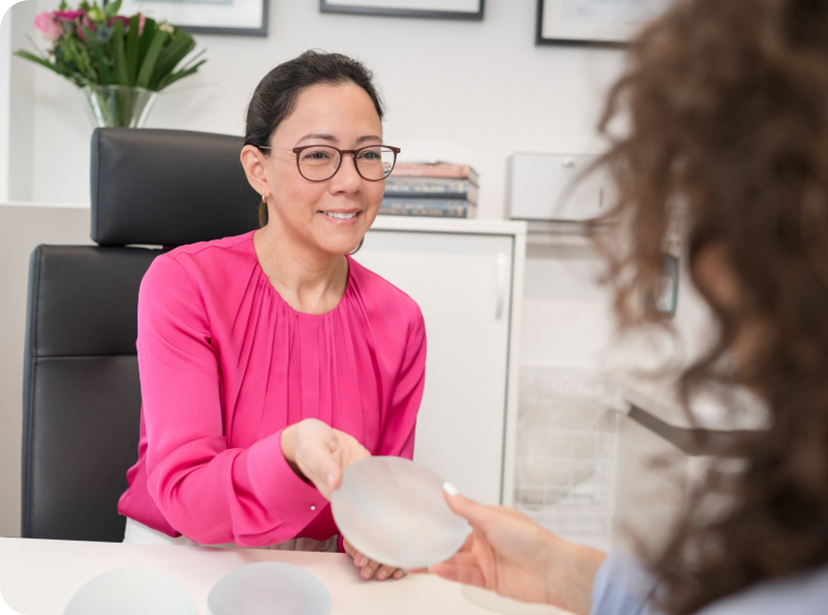
Preparation
Your aesthetic plastic surgeon will see you immediately before the operation. For harmonious proportions, an optimal shape and symmetry of the breasts, the surgical plan is marked on your breast with a special marker. The anesthetist will then discuss the procedure with you again. Before you are accompanied to the operating theater, you will be given a preventive antibiotic.

The OP
After careful disinfection and sterile covering of your breasts, the operation can begin. The surgeon first anesthetizes the intercostal nerves and also injects a tumescent solution. This anesthetizes the tissue and prevents the formation of bruising. While you sleep or are distracted by a movie on 3D glasses, the entire surgical team works with high concentration. The procedure takes two to three hours, depending on the findings. The wounds are sutured with fine self-dissolving skin sutures. Drainage tubes are only inserted if deemed necessary and can usually be removed the following day. The operation takes about 2.5 hours.

After the procedure
Once the wound has been dressed, the surgical team will fit you with the appropriate support bra (compression bra) ordered for you. Immediately after leaving the operating theater, patients are usually awake and pain-free and can eat or drink something. Normally, you can be picked up after a short observation period. You will receive a letter in which all behavioral measures are noted. You will also find the dates for follow-up examinations and a telephone number where you can reach your aesthetic plastic surgeon at any time.
Before and after pictures of a breast reduction
It is not permitted by law to publish comparative visual representations of the success of treatment in the form of before and after photos on the Internet. This is laid down in Section 1 (1) No. 2 of the Therapeutic Products Advertising Act. Nevertheless, such before and after pictures of a breast reduction can be used to inform patients during the consultation. It goes without saying that data protection regulations are observed. The pictures were taken with the consent of the patients and help to show you the possibilities and limitations of cosmetic surgery. In addition, a special bra in the desired target size can illustrate how large the breasts will be after the operation.
FAQ – Frequently asked questions
The average size of breasts varies according to body weight, age and ethnic origin. In Australian women with a BMI of 18.5 to 24.9, for example, an average volume of 327 milliliters was measured 2 . In Turkish women between the ages of 18 and 26 (BMI 20 to 25), the calculated volume was 407 milliliters 3 . In American women, the average for women aged 22 to 82 years was 405 milliliters 4 .
As the size of the breast increases, the distance from the jugular fossa to the nipple increases. The volume of a breast can therefore be calculated using certain measured variables 5 . Alternatively, the breast volume can be determined using a 3D scanner or magnetic resonance imaging.
It is generally accepted that a giant breast (gigantomastia) is present if at least 1500 grams or more than 3% of the total body weight is removed during breast reduction surgery 6 . There are various criteria for defining larger-than-average breasts, also known as macromastia or mammary hypertrophy. Some refer to a D-cup size as oversized breasts 7 .
The female breast develops during puberty under the influence of oestrogen. The estrogen estradiol is produced in the ovaries around the time of ovulation and in the placenta during pregnancy. In rare cases, excessive breast growth can also be caused by pregnancy 8 . Breast growth as a side effect of certain medications, such as penicillamine (rheumatism treatment) or cyclosporine (suppression of the immune system), is exceptionally rare.
On average, women with large breasts have a higher body weight 9 . Oestrogens are also produced in the cells of adipose tissue with the help of a specific enzyme (cytochrome P450 aromatase) 10 . With an increased body fat percentage, both the fatty tissue and the glandular tissue of the breast can therefore increase. Why some women have a larger or smaller glandular body than others is largely unexplained. Elevated estrogen blood levels do not appear to play a role here 11 . Excessive breast growth cannot be explained by increased estrogen sensitivity either 12 . It is possible that the triggers for breast growth can only be found over a limited period of time and only in the affected breast tissue.
According to SGB V § 27, insured persons are entitled to medically necessary treatment for illnesses. For example, health insurance covers the costs of a breast reduction if a skin rash does not improve despite months of treatment by a dermatologist. In this case, there is a medical necessity. Another reason for cost coverage is cases in which an orthopaedic or trauma surgeon assumes a causal connection between a back condition and large breasts. In addition, it is often necessary to prove that conservative treatment measures have not helped to improve the symptoms. If the health insurance company pays for a breast reduction on the basis of a medical indication, the benefits in accordance with § 12 para. 1 SGB V must not exceed what is necessary. Justified aesthetic claims that require additional liposuction, for example, are not covered by health insurance.
In 95 percent of patients, the “new breast” has reached its final size after 3 months and its final shape after 6 months. The change in size can be seen immediately after the procedure. An unavoidable slight swelling will disappear after a few weeks. While the final result can already be seen, scar healing is not yet complete at this stage. Depending on age and predisposition, the scars may be firm, raised and reddened in the first few months. Regular massaging of the scar and the application of silicone patches support rapid and delicate scar healing. The skin mantle adapts slightly to the new shape. Especially between the nipple and the underbust crease, the tissue usually gives a little. No noticeable changes are expected one year after the operation.
The patient’s level of suffering is decisive for the timing of the operation. If very large breasts already cause considerable physical and emotional discomfort during puberty, we recommend a detailed consultation in the presence of the parents. If the breasts of young women have not yet finished growing, there is a risk that the size of the breast will increase slightly after the reduction. The surgical risks depend to a certain extent on the physical conditions. They are generally lower in young, healthy patients than in older patients and smokers. Around two thirds of patients can still breastfeed after a breast reduction 13 .
Aesthetic breast operations, such as breast lifts, breast augmentation or breast reduction, are an integral part of training as a plastic and aesthetic surgeon. A good education, many years of experience and a certain talent are certainly important qualities. It is best if the attending physician and plastic surgery expert is characterized by all three qualities. You can get an idea of human qualities such as empathy, a sense of responsibility and reliability during the consultation. To be able to judge the skill involved in cosmetic surgery, you have to have observed many surgeons at work.
So how can you form an opinion? Take a look at the CVs of the surgeons. A doctor with good training and a lot of experience will usually make this information readily available on the Internet. Be suspicious if you only find seals and awards from private companies on a website. These eye-catchers are often available for purchase. Certificates from state universities, scientific awards from specialist societies and management positions such as senior physician or chief physician generally testify to a certain level of professional qualification.
Your satisfaction is our focus. That is why the doctors at CenterPlast take the time to get to know your goals in detail and show you ways to achieve them. When performing a breast reduction, a harmonious relationship to the patient’s physique must be taken into account. In order to create a youthful and beautiful breast shape, you should choose the most suitable technique for your cosmetic surgery. An open and trusting discussion with your plastic and aesthetic surgery expert is an important prerequisite for achieving your goals.
The surgical risks are influenced by various factors. Depending on your state of health, physical condition and lifestyle habits, the potential risks may be higher or lower. Numerous studies show that older age, obesity and cigarette smoking increase the risks 14 . In addition, the rate of possible complications is also influenced by the extent of the surgical procedure (removal of 500 versus 1500 grams). The risks include post-operative bleeding, accumulation of wound fluid, inflammation, wound healing disorders and circulatory disorders of the nipple. As a guideline, the risk of complications requiring treatment in patients in the USA is estimated at 1 to 2% 15 . Bear in mind that study data on surgical risks cannot be applied to every country, every patient, every clinic and every practitioner.
During breast reduction surgery, it can never be completely avoided that small amounts of blood from hair vessels leak into the wound. Small amounts of blood components are broken down and excreted by the body. Particularly in the case of large wounds, there is a risk of blood accumulating in a tissue cavity. This is referred to as a bruise. To avoid bruising, a fine drainage tube is inserted into the wound during breast surgery. The tube transports the blood to the outside and can usually be removed the following day. The CenterPlast doctors often manage without drainage. An unremarkable blood test with normal coagulation values does not rule out a bleeding tendency. Therefore, the decision whether to place a drain should be made during the surgical procedure.
In a beautiful youthful breast, the nipple lies on the highest point of the breast when standing. Once the excess tissue in the lower part of the breast has been removed, the nipple must be lifted. In order to be able to move the nipple, it must be detached from the surrounding tissue. To ensure that the nipple heals well and the sensation is maintained, the vessels and nerves leading to the nipple must be protected.
The tissue that connects the nipple to the chest wall after it has been detached is called the stalk or tissue bridge. If the tissue layers above the nipple are severed, this is referred to as a lower tissue bridge. The techniques are often named after the surgeon who first described them:
- – Lower tissue bridge 16
- – Tissue bond upwards and downwards 17
- – Fabric bridge to the side and center 18
- – Central tissue bridge to depth 19
- – Tissue bridge to the center and top 20
Every technology has certain advantages and disadvantages. In very large breasts, the lower tissue bridge is usually shorter and therefore ensures a better blood supply to the nipple. No significant differences were found between the different tissue bridges with regard to nipple sensation 21 . Compared to the lower tissue bridge, the upper half of the breast is fuller in the upper central tissue bridge. One advantage of the upper central tissue bridge is that the technique can be combined with the inner bra method. The inner bra technique can be used in breast lifts to give sagging breasts more fullness.

AUTHOR
Dr. Stéphane Stahl
We provide you with extensive expert knowledge in order to select the best possible treatment path together with you.
Privatdozent Dr. med. Stéphane Stahl is the former Director of the Clinic for Plastic, Reconstructive and Aesthetic Surgery / Hand Surgery at Lüdenscheid Hospital. Dr. Stahl studied medicine at the Universities of Freiburg and Berlin.
He passed the European specialist examination for plastic and aesthetic surgery in 2011 and the German specialist examination in 2012. This was followed by further specialist qualifications and additional qualifications (including quality management, medical didactics, physical therapy, emergency medicine, laser protection officer, hand surgery) as well as prizes and awards.
In 2015, he completed his habilitation in plastic and aesthetic surgery in Tübingen. He is an experienced microsurgeon, sought-after expert witness and regular speaker at specialist congresses. Following a multi-stage selection process, Stéphane Stahl became a member of the American Society for Aesthetic Plastic Surgery (ASAPS), one of the world’s largest and most influential specialist societies for aesthetic surgery.
His authorship includes numerous articles in prestigious peer review journals and standard surgical textbooks.
- Jørgensen MG, et al., 2021, Aesthet Surg J. ↩︎
- Coltman CE, et al., 2017, Ergonomics. ↩︎
- Avşar D. K., 2010, Aesthet Surg J. ↩︎
- Loughry CW, et al., 1989, Annals of plastic surgery. ↩︎
- Longo B, et al., 2013, Plast Reconstr Surg. ↩︎
- A. Dancey, et al., 2008, J. Plast. Reconstr. Aesthetic Surg.; H. Dafydd, et al, 2011, J Plast Reconstr Aesthet Surg. ↩︎
- Mundy LR, et al., 2017, Plast Reconstr Surg. ↩︎
- A. Dancey, et al., 2008, J. Plast. Reconstr. Aesthetic Surg. ↩︎
- Brown N, et al., 2012, Am J Hum Biol. ↩︎
- Simpson ER, et al, 1989, Endocr Rev 1989 ↩︎
- Das L, et al., 2019, Endocrine. ↩︎
- Jabs AD, et al., 1990, Plast Reconstr Surg. ↩︎
- Cruz NI, et al., 2007, Plast Reconstr Surg. ↩︎
- Jørgensen MG, et al., 2021, Aesthet Surg J. ↩︎
- Gupta V et al., 2017, Aesthet Surg J. ↩︎
- Robbins T.H., 1977, Plast Reconstr Surg. ↩︎
- McKissock P.K., 1972, Plast Reconstr Surg. ↩︎
- Strömbeck J.O., 1960, Br J Plast Surg. ↩︎
- Balch C.R., 1981, Plast Reconstr Surg. ↩︎
- Orlando J.C., et al., 1975, Br J Plast Surg ↩︎
- Silhol T, et al., 2019, J Plast Reconstr Aesthet Surg.; Muslu Ü, et al., 2018, Aesthetic Plast Surg. ↩︎
You might also be interested in

Personal advice
We take time for you and offer you customized advice and treatment for your individual result.
